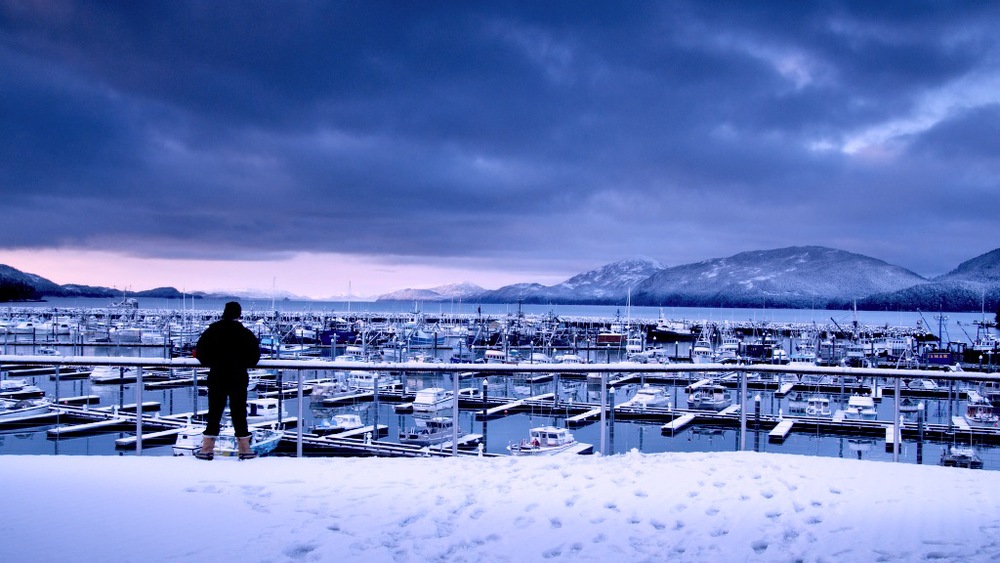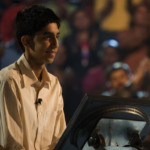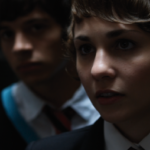
Shooting RED For Documentaries
Posted on Apr 30, 2010 by Alex Fice
Most people wouldn’t take a new camera in to very harsh arctic conditions let alone a new camera that shoots on hard drives. But Director Jon Akomfrah and DP Dewald Aukema have been pushing boundaries ever since they started shooting together. They were in Alaska to shoot Ghosts of The Exxon Valdez and came back with some stunning images but also with some worrying green flashes to deal with
Has there been many documentaries made with the RED One camera? We hear mostly about promos, commercials and a few movies but have people trusted running the camera for long periods as is usual with docos? Not only did Director Jon Akomfrah and DP Dewald Aukema want to use the RED for their documentary Ghosts of the Exxon Valdez they also wanted to take it in to possible -30˚C temperatures in Alaska. Mix that with high temperatures for some footage to be shot in Dallas and you have some question marks, especially after rumours of over heating cameras posted through the reduser forum – maybe a case of too much information if there ever was one.
The documentary wanted to revisit the scene of one of the world’s worst oil spillages, which happened in 1989, the doc was to be transmitted exactly 20 years after the incident. Jon Akomfrah wanted to bring a cinematic quality to it, as an aesthetic for sure but also to give us some idea of how beautiful the place was before it was devastated by the oil. Cinematic usually means film but the next best thing for Jon was the RED.
If you know Dewald then you already know that this is an individual who follows no fashion or custom, which helps him working in the UK, where his South African spirit delights in not conforming. But he has been pushing the HD boundaries in this country a while and shot a very early HD drama for the BBC back in 2004 called Every Time You Look At Me about a relationship between a physically handicapped couple (High Definition Magazine Issue Six, March 2004). Now he has embraced the RED revolution but not before he asked some very knowledgeable part time RED employees if his money was safe with this new camera system. Once he heard that this was the ‘real deal’ and perhaps more importantly the cash backing was there, Dewald bought his RED and one of the first jobs he was to used it on was on the Exxon Valdez doc.
But there is some history here. Director Jon Akomfrah has been shooting with Dewald for about 14 years and it seems they’ve always done things differently, Jon: “We started working with the Digibeta 700 and 790 in the late eighties so we were part of that first group who couldn’t afford to shoot 16mm or Super 16mm for documentaries. We started using them out of necessity but then really got to like the peculiar quality that it had. They way you could get in to the menu and start playing with the luminance and curves etc.. So when we heard about the RED three years ago we both registered for one independently of one another because it seemed to offer some answers to questions we were beginning to raise with Digibeta.
We needed more resolution because we were playing with the image so much with grads and filters and all of that and basically de-saturating it in-camera so much that the images were starting to look slightly inferior. I was getting less than 1K on Digibeta and here is this camera that could give me four times that! Also the actually size of the files were interesting and all at that price!”
Jon calls the move from his Digibeta to RED as a ‘species jump’ but with a steep learning curve as part of the deal. “The workflow seems unconventional to say to least. The standard lament that we heard when we went to a post production house with our shooting plan was ‘….could you shoot it on something else’. Also I realised that we had to work on Final Cut Pro, before that we were wholly and absolutely Avid.
“To be honest I think one of the things that RED did for people like me was force me to see Final Cut in a new way. We did try everything we could to hang on to our Avid way of working but we finally embraced FCP and I’m glad we did it in the end.”
The decision to use a RED camera was tempered with the knowledge that they would be working in Alaska with temperatures dropping to -30˚C, Jon was worried: “We were also going across terrain that required the camera to be working whilst moving. So we spoke quite a lot to RED about this and they assured us that the camera could cope with the extreme temperatures that we were talking about. But it didn’t like the heat, they said. As it turned out we didn’t have any problems with the cold but we did have hiccups with some vibrations on some transport. It would drop and frames and then just give up. But we managed to solve it in the second week as there was a new mount that could absorb those shocks.”
On the face of it Jon saw this coming together of documentary and RED as a perfect marriage especially as they were looking to shoot in Alaska between March and August last year. The weather then would have been pretty much perfect. Blue skies and a little bit of snow. But as the commissioning processed dragged, winter came in to view: “That meant that everything was essentially going to be white. The one thing I knew that digital cameras couldn’t cope with was white. That has been our experience over the years.”
TESTING IN THE COLD
So how do you test for such an environment with a brand new camera that probably hasn’t been in that place before, it’s called a leap of faith! “We couldn’t afford to shoot 35mm on a documentary for the BBC, I didn’t think the f900 could cope with it so we hoped the RED would work.”
DP Dewald had his own concerns about using his RED in such temperatures, “Of course I was concerned. RED’s officially line was that they had taken it down to about -22˚C and it was fine. It’s like a computer and they are quite happy with the freezing cold, it’s the hot that gets them. We didn’t shoot any compact flash it was all on the two RED hard drives. We were shooting about two and a half hours per drive, you’re very seldom shooting more than five tapes on say a Sony 900. It wasn’t that cold in Valdez and we were going in and out depending on the light, it when we went in land in Alaska that it could go down to -40˚C. We certainly didn’t put the camera out that for six hours at a time, you couldn’t be there for six hours anyway.
“We had absolutely no hassles with the camera whatsoever which was a total surprise to me. With the Sony cameras I just know I would have had trouble there, especially jumping in and out with humidity levels. There would have been RF signal problems all the way through on the tape deck side.
“What really excites me about the camera is the pictures it produces, the stuff we got in Alaska because it was middle winter, its just white and black or dark gray essentially, so what we were doing was exposing quite differently to anywhere else because you have a near 100 percent reflectant quality. The way we exposed it was to drag it down a bit more and not let any of the highlights go which you should be doing anyway. There is a dynamic range in the camera. It does seem to hang on to highlights sometimes more than film and at other times much less so. I think it depends on the overall dynamic range which you’re working with. For instance in Alaska we were working with a fairly narrow dynamic range because it was all white or gray. It seemed to hang on to all the subtle graduations of all of those highlights all sitting in the 90 percent plus sort of range. It’s quite beautiful when it does that.
“The other concern obviously is how it will hang on to the dark side. It actually produced that beautifully so I was quite astounded by the dynamic range. Since then I have put it in to other situations where you’re dealing with very different required dynamic range and it’s certainly not as good as film.”
DATA MANAGEMENT
Jon and Dewald got in to the habit of reviewing the footage at night and then transferring the RAW files on to Firewire drives, but not any old drives, “I’ve discovered these fantastic drives called Sonnet F2, they are relatively expensive in comparison to say Lacie which are too consumer. The Sonnet’s are much smaller, much more robust. We had separate drives in two cases so you do two backups on RAID 0 and it’s incredibly quick. A full mag (two and a half hours) takes about an hour to dump. You get back to the hotel and initiate the first one and you go and have your supper. You get back and do your check sums, then do a spot check and if there were certain scenes that I knew I would have to look at I would make a note of that on my iPhone. Then you kick start your B backup on a second drive altogether and go and have two or three drinks!
“What I loved was the fact that when Digibeta first hit us in 1994 you would sit with the director and go through the rushes and there would be a dialogue. That disappeared after a while because people got lazy, with the RED it’s come back. It’s very important and I think it something that’s got lost. So while the second back up is happening you just take a few .r3d files and manipulate them and discuss where we are going with them. It’s not a big deal as long as you’ve got a system in place. If you think how incredibly dangerous it was with film, it’s nothing like that. It’s not even as risky as tape because you’re sitting with two masters.
THE EDIT
The edit was started at Christmas not realizing that the BBC would pull the TX date forward to a date 20 years on from the disaster. Jon was still on the learning curve, “Starting the edit was nightmarish I have to say, there were things I just hadn’t realized that were unique problems for shooting documentaries. You’re gathering an enormous amount of data in interviews with a camera system that had been designed to shoot short programming, commercials and so on. We found that if you shot an interview over about ten minutes it had problems. We were getting green flashes on the proxy files and we wondered what the hell that was. It took a while talking to them and to 4K London who helped us out with the workflow to work out that this was just a proxy problem nothing to do with the RAW files at all. Also finding the best way to configure Final Cut Pro to deal with three different types of material. We had the RED footage but also Newsreel from the time on different formats. So getting our head round marrying the RAW files with this other material was difficult. But in the end nothing we encountered seemed big enough to stop you from wanted to work with the camera. The green flash stuff would have stopped me going near any other camera but it didn’t seem to stop us with RED as you knew the proxies without green flashes looked so good.







